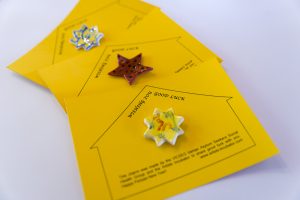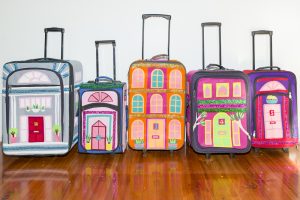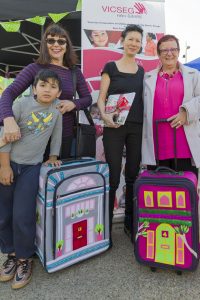Case Study 1: Belonging and the Transient Home
Broadmeadows, Melbourne, Victoria, Australia, 2016
Belonging and the Transient Home (2016) was a community-based public art project developed in collaboration with the Vicseg New Futures Asylum Seekers Social Health Persian Group, a not-for-profit dedicated to supporting asylum seeker communities to resettle in Melbourne. As an artist / curator / researcher, I developed a relationship with this social health group whilst working on an earlier socially-engaged art project in the nearby suburb of Glenroy, aptly named The Flavours of Glenroy (2014), and then was invited to work specifically with this asylum seeker group. They invited me as a guest artist to collaborate, co-create and develop a project which would allow the social group to engage with the broader community.
In the Australian context, there has been increasing controversy over the support of asylum seekers, with the issue becoming increasingly politicised in relation to their inhumane treatment by the government, the laboriously slow processing of visas for communities in need, and extremely poor detention conditions. The development of this project was to consider alternative ways of supporting their resettlement and looking at how collaboration can play a role in forging stronger social connections to provide a space for expression and reflection in difficult journeys of migration.
Those who attended the group were six Kurdish Farsi-speaking families with children under five living in Broadmeadows, Victoria and originally from Iran who had arrived as asylum seekers due to social and political marginalisation. Broadmeadows is a middle-ring suburb north of central Melbourne and has a long history of new immigrant settlement, with immigration detention facilities and services located in the area. Broadmeadows is considered one of the most disadvantaged neighbourhoods in Melbourne: The Australian Bureau of Statistics (ABS) Socio-Economic Indexes for Areas (SIEFA) Index of Relative Socio-Economic Disadvantage (IDSD) in 2016 ranked the Hume Local Government area at Level 2 most disadvantaged, below the average for Greater Melbourne (which is between Level 3-4 in a ranking scheme of 1-5). The Index takes into account ABS statistical information and maps disadvantage across Australia. Taking these local place conditions into consideration during the site analysis of the project indicated that this group was in need of further social support, hence my role in developing socially engaged creative activities for the families to participate in.
Each entire family was invited to attend the sessions, but only the women and children under 5 years attended. The fathers generally used this time to manage other household issues. For these families, it was an unsettling period due to uncertainty in their citizenship status. Those arriving as asylum seekers have limitations on being able to work and no clarity on whether they will obtain permission to remain in Australia. The weekly social health group session incorporated time for the families and children to socialise and build relationships with other local families in the same circumstance, guest speakers from the community health sector, and creative activities introduced by myself as an artist to this group. These activities were given as a relaxing and calming activity, providing a way to express and reflect upon their circumstances.
Over a period of three months, I spent this time getting to know the families. As an action researcher, I viewed these family grouping sessions as mobile ‘studio’ sessions since I travelled to the location of their group meetings. During this process, the development of my methodological approach of engagement with the families was influenced by an early childhood educational philosophy: The Reggio Emilio Atelier (meaning ‘studio’ in Italian) approach. I viewed these sessions as workshops where the participants, social workers and I became co-learners in the studio environment, as per this method. Seeking cultural advice from Australian-Iranian artist Sofi Basseghi, I developed workshops based on the Persian Nowruz (New Year) tradition of making ceramic good-luck charms, which are given to family and friends during the coinciding celebrations. We studied Persian ceramics and considered patterns and text, which would convey messages of good luck, intending to share what we created with the wider community.

After gaining a deeper understanding of the group’s circumstances through the collective creative process, we workshopped, discussed and reflected further upon ideas in relation to home, resettlement and their feeling of transience as asylum seekers. The group identified with the concept of home as evolving, mobile and unfixed. As the lead artist, taking into consideration that the project was for the parents and children, I considered how I could develop the creation process to build on their ‘charm-making’ and appeal to the children in a playful way. This led to the transformation of suitcases into ‘Transient Homes’ to represent the status of the families and contain the good-luck charms in production, which became a public art installation. Suitcases were upcycled and transformed playfully with coloured felt, resembling different types of cosy housing attractive and accessible to the children.

In April 2016, we were supported by the City of Hume to participate in the Broadmeadows Street Festival, presenting the project to the local community. The festival gave the families an opportunity to participate and to be represented in the local community. The families socialised with other community members through the gifting of their good-luck charms as a way of initiating conversations by sharing their cultural traditions. The event even led to meeting the current Mayor of Hume, Cr Stella Kariofyllidis, who was very supportive of the group in their creative participation. The families also enacted ‘The Great Transient Home Race’, an enjoyable and active event for local children. The project attracted local media attention in the Hume Leader (Savino, 2016), and the children of the group were proud of being featured in our project. These public aspects of participating in a local festival greatly assisted this new community in building confidence and gaining further connections to the local existing community through the process of building a creative project and sharing it publicly together.

